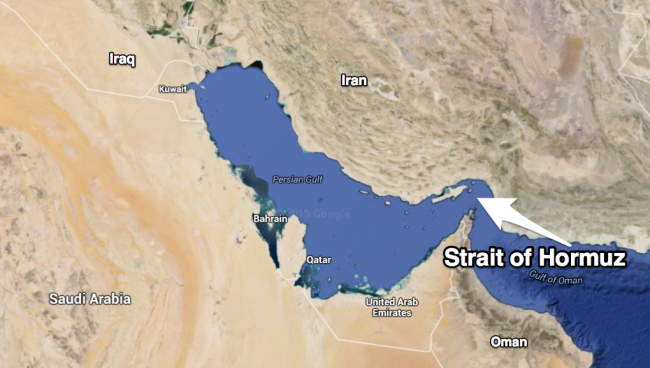On Dec. 30, the United States accused Iran of conducting a “highly provocative” rocket test in the Strait of Hormuz. According to a U.S. Central Command spokesperson, at the time of the alleged rocket test on Dec. 26, a U.S. aircraft carrier, a U.S. destroyer and a French frigate were nearby.
The incident touched off a new round of condemnations in the U.S. political establishment, particularly among Republicans. Senator John McCain said: “A rush to sanctions relief threatens to embolden an increasingly aggressive Iranian regime that has no intention of normalizing relations with the West or of retreating from a malign policy intended to destabilize the Middle East.”
The Strait of Hormuz connects the Persian/Arabian Gulf with the Sea of Oman. At its narrowest point, it is only 21 miles wide, of which only 6 miles are navigable. A distance of 12 nautical miles (14 miles) off the shore of any country is considered part of its territory. This means that, at its narrowest point, the Strait has no international water; all of it is territorial waters of Iran to the north and Oman to the south.
Referring to the alleged firing of the rockets, a French military official, speaking on condition of anonymity, said the French military did not consider it to be a threatening event since the rocket fire clearly wasn’t directed at the Western fleet.
Iran has stated that it did not conduct rocket tests in that time frame. But regardless of whether there was a rocket test or not, the fact is that the U.S. is accusing Iran of carrying out “highly provocative” tests off its own coast. The U.S. has always acted on the premise that it has a right to have a strong military presence in the Persian Gulf. The U.S. naval presence is not just aircraft carriers and destroyers, which were supposedly threatened by this “provocative” test. U.S. nuclear armed submarines are often present in the Sea of Oman, also off the coast of Iran.
It is the height of imperialist arrogance to consider that level of military presence off other countries’ shores routine, while considering a rocket test by a country off its own shore to be “highly provocative.” If ships from Russia, China, or another U.S. adversary traveled even within a hundred miles of U.S. shore, the U.S. government and corporate media would likely call that the highest form of provocation. But the imperialist narrative has it that Iran does not even have a right to conduct tests off its shore.
Iran does not have any other access to the open seas. The Caspian Sea to the north is not really a sea but the world’s largest lake. So it can only conduct naval exercises in the Persian Gulf, the Sea of Oman and the Strait of Hormuz in between, all of which the U.S. Navy effectively considers to be its own.
Far from being a harmless inconvenience, U.S. naval presence in the Persian Gulf has been a constant menace for Iran. In 1987, near the end of the Iran-Iraq war, the U.S. Navy attacked and sunk several Iranian vessels. On July 3, 1988, U.S. Navy warship USS Vincennes shot down an Iranian civilian airliner, killing all 300 people on board, including 71 children. The U.S. claimed that the airliner had made dangerous maneuvers or was carrying out a military mission over international waters.
Years later, the U.S. was forced to acknowledge that, contrary to its initial claims, the U.S. warship had not been in international waters, but in Iranian waters. In 1996, the U.S. government had to settle in the International Court of Justice by paying $61 million in compensation to the families of the victims. But to this day, the U.S. has refused to admit responsibility or apologize. In fact, the crew of the USS Vincennes were all awarded combat-action ribbons. Lieutenant Commander Scott Lustig, the air-warfare coordinator, received the Navy’s Commendation Medal for “heroic achievement.”
The other recent development in U.S.-Iran relations is the possible implementation of new sanctions against Iran for having conducted a missile test. Iran is said to have test fired a medium-range ballistic Emad rocket on October 10. By all accounts, the rocket had no cargo, nuclear or otherwise. But this missile launch is considered by the U.S. and its allies to be dangerous because the missile is “capable” of carrying a nuclear bomb. This despite the fact that the International Atomic Energy has recently issued a report concluding that Iran has no active nuclear weapons program, much less an actual nuclear bomb. For now, the Obama administration has put the implementation of new sanctions on hold, fearing that such action will threaten the nuclear agreement it reached with Iran in July 2015.
Through such military tests and maneuvers, Iran is sending the same message that it has for over a decade now. The message is that the country will defend itself if attacked. This is, in part, the reason Iran has not been bombed or invaded by the United States during the years of “all options are on the table.” It is important for the anti-war movement in the U.S. to emphasize that the aggressor in this conflict is not Iran; it is the U.S.






